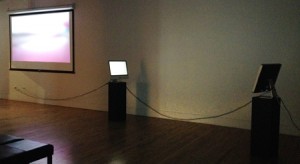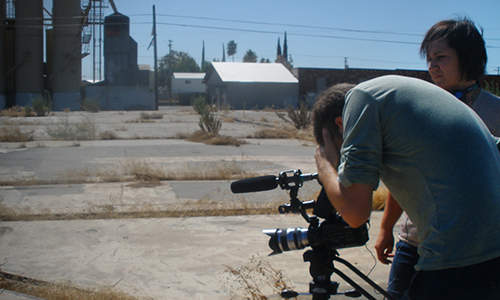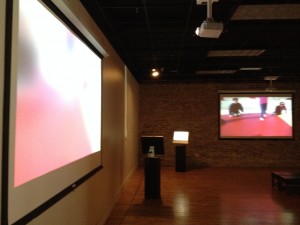Sean Clute: Memory Reset and the Great Modesto Bouncy Thing
January 29 to February 27, 2015
Reception Thursday February 5, 2015 at 5:30 pm
Artist Talk at 2:30 pm, Art Department Digital Media Studio.
Sean Clute is an interdisciplinary artist, composer and performer. His work has been presented internationally at venues such as The Kitchen, San Francisco Museum of Modern Art, MuseumsQuartier Wien, ISEA2014 – Dubai, and the Autonomous Mutant Festival. Currently, Clute lives in Vermont where he is Co-Artistic Director of intermedia dance company DOUBLE VISION, the founder and director of the Media Arts Research Studio (MARS) and Assistant Professor of Digital Art at Johnson State College. Occasionally, he attempts to cross-country ski.

Memory Reset and the Great Modesto Bouncy Thing
Memory Reset and the Great Modesto Bouncy Thing is a video installation that uses a distributed network to visually reconstruct friends jumping together on an inflatable structure in the outskirts of the Central Valley, CA. Projected on two screens, found footage of the jumpers is blurred, cut-up and colorized. The viewer can imagine the composite of each screen depicting the original footage, while if viewing only a single screen, the viewer experiences only part of the total. The video installation is a reminder of how both the brain and digital technology can record, store and transform memories.
As English poet Stephen Spender exclaimed:
“Memory is not exactly memory. It is more like a prong, upon which a calendar of similar experiences happening throughout the years, collect. A memory once clearly stated ceases to be a memory, it becomes perpetually present, because every time we experience something which recalls it, the clear and lucid original experience imposes its formal beauty on the new experiences. It is thus no longer memory but an experience lived through again and again.”
The video installation Memory Reset, while influenced by the idea of memory, isn’t an attempt to emulate it as a human would. Rather, video pixels are programmed to algorithmically construct half of the computer’s video matrix. For example, one screen may present half of the colors used in the original while the other projector shows the remaining half. Furthermore, the video installation randomly cycles through many processes (nothing is fixed). Because two computers are networked, the subsequent projections always sum the complete image.


